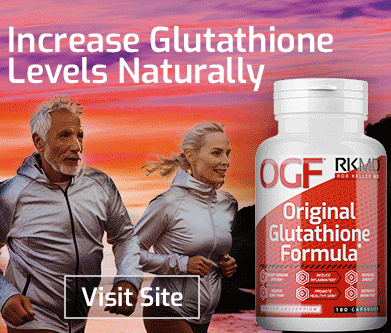Original Glutathione Formula – More Than Just a Great Glutathione Supplement
If you’re interested in improving your overall wellness, increasing your glutathione levels is a great place to start.
Glutathione is your body’s master antioxidant, and as such, it has a wide reach. Glutathione is crucial for preventing age-related diseases, supporting your immune function, promoting fertility, and ensuring your enzymes function as needed, among many other functions. There’s a reason why it’s called the master antioxidant—it has a lot of roles.
Despite how important glutathione is, though, its production can decline over time. To combat this, we’ve created Original Glutathione Formula (OGF), a unique formulation that contains all of the glutathione-boosting ingredients your body needs to increase glutathione production. The ingredients offer some added benefits to your health, as well, making them all the more potent.
The Ingredients of OGF
An interesting fact, Original Glutathione Formula (OGF) does not actually contain any glutathione—there’s a reason for this.
Glutathione has a notably low oral bioavailability, meaning when you take it as an oral supplement, the body does not absorb very much of it. As a result, oral glutathione supplements either lack effectiveness or require a lot of glutathione in order to see any benefit.
OGF is our solution to this problem: Dr. Keller created a formula that boosts your body’s natural glutathione production through various means, including providing your body with glutathione’s building blocks and activating your body’s glutathione production. While OGF does not supply your body with glutathione, it does something even better: it provides the essential ingredients to help your body produce more of this vital antioxidant.
Let’s explore some of the ingredients of OGF that allow your body to kickstart its glutathione production and increase the levels to a point where you can see improvements in your immune function, energy, and cognitive functioning.
Vitamin C: A Cell Protector
Vitamin C is one of the best anti-aging supplements because it protects your cells from oxidants and free radical damage, similar to glutathione. In fact, vitamin C and glutathione are deeply connected and their functions as antioxidants are mutually essential to each other.
Both glutathione and vitamin C transform from their reduced forms to their oxidized forms, which is what aids the elimination of free radicals. The oxidized forms are then reduced back to their original state through reductive enzymes, allowing these antioxidants to eliminate free radicals over and over again. However, glutathione and vitamin C rely on each other for these processes, which is why vitamin C is crucial for ensuring glutathione can continue to neutralize free radicals.
Beyond its relationship with glutathione, vitamin C offers other benefits, including reducing blood pressure, lowering the risk of gout, and increasing iron absorption (which then decreases the risk of iron deficiency). However, vitamin C is an essential vitamin, meaning your body cannot produce it, so it must be taken in through food or supplements.
NAC: A Respiratory Supporter
NAC, N-acetyl cysteine, is a vital ingredient for the production of glutathione—without it, your body cannot produce glutathione.
Beyond this role, though, NAC also supports your respiratory system; it relieves symptoms of respiratory conditions by acting as an expectorant, loosening the mucus in your airways. Some studies even suggest that taking NAC as a supplement can help improve symptoms of COPD. This is likely because, by thinning the mucus in your bronchial tubes and boosting glutathione levels, NAC can help to decrease the frequency and severity of coughing and respiratory attacks.
The ability of NAC to replenish glutathione has also been shown to boost brain health. Animal studies have even suggested that NAC may be able to slow the loss of thinking ability and memory in those with Alzheimer’s disease.
L-Glutamine: Providing Energy to Immune and Intestinal Cells
L-glutamine is yet another building block of glutathione, making this ingredient crucial for ensuring your body has everything it needs to produce more glutathione.
Alongside its critical role in the immune system, including its role as a food source for immune cells, glutamine is also crucial for your intestinal health; glutamine is an important energy source for your intestinal cells and can also maintain the barrier between your intestines and the rest of your body, protecting against a leaky gut.
Quercetin: A Heart Protector
Quercetin is a powerful antioxidant that can protect your cells from oxidative damage. It can also help inhibit inflammation in the body and prevent the growth of many viruses, two features that support your immune system.
Quercetin may also protect your heart health by preventing blood vessel dysfunction due to endothelial dysfunction and reducing risk factors of heart disease such as high blood pressure and atherosclerosis.
Alpha-Lipoic Acid: Reducing Signs of Aging
Alpha-lipoic acid is known for its ability to strengthen the antioxidant network. One of its roles includes regenerating antioxidants, glutathione included, which then keeps up your glutathione levels.
Alpha-lipoic acid can also improve your skin health by protecting the skin from damage (especially sun damage) and potentially reducing visible signs of aging.
The Power of Collaboration
There’s a reason why working as a team is so common—everyone can bring their individual strengths to the project, leading to exceptional rewards for everyone, and the same occurs with the ingredients of OGF.
Above, we listed the benefits offered by each ingredient of OGF, but the true magic happens when all of these ingredients are combined into one product: Original Glutathione Formula.
Thanks to each carefully chosen ingredient, OGF is able to increase glutathione levels 5 different ways:
- Provides the essential ingredients for your body to make glutathione.
- Activates Nrf2, signaling your body to make glutathione.
- Enhances glutathione-creating nutrient absorption.
- Maximizes enzymatic reactions promoting glutathione synthesis.
- Recycles the glutathione your body has created.
The ingredients of OGF are chosen because each plays a crucial role in glutathione production while also promoting your body’s health in other ways. Each ingredient is effective on its own, but the greatest benefits are seen through their combination.
Learn more about OGF or try it out for yourself and see how its powerful ingredients work together synergistically to improve your health.
References
Wei, T., Sachin Sunil Thakur, Liu, M., & Wen, J. (2022). Oral delivery of glutathione: antioxidant function, barriers and strategies. Acta Materia Medica, 1(2). https://doi.org/10.15212/amm-2022-0005
Lee, E., Park, H. Y., Kim, S. W., Kim, J., & Lim, K. (2023). Vitamin C and glutathione supplementation: a review of their additive effects on exercise performance. Physical activity and nutrition, 27(3), 36–43. https://doi.org/10.20463/pan.2023.0027
Juraschek, S. P., Guallar, E., Appel, L. J., & Miller, E. R., 3rd (2012). Effects of vitamin C supplementation on blood pressure: a meta-analysis of randomized controlled trials. The American journal of clinical nutrition, 95(5), 1079–1088. https://doi.org/10.3945/ajcn.111.027995
Choi, H. K., Gao, X., & Curhan, G. (2009). Vitamin C intake and the risk of gout in men: a prospective study. Archives of internal medicine, 169(5), 502–507. https://doi.org/10.1001/archinternmed.2008.606
Hurrell, R., & Egli, I. (2010). Iron bioavailability and dietary reference values. The American journal of clinical nutrition, 91(5), 1461S–1467S. https://doi.org/10.3945/ajcn.2010.28674F
Pirabbasi, E., Shahar, S., Manaf, Z. A., Rajab, N. F., & Manap, R. A. (2016). Efficacy of Ascorbic Acid (Vitamin C) and/N-Acetylcysteine (NAC) Supplementation on Nutritional and Antioxidant Status of Male Chronic Obstructive Pulmonary Disease (COPD) Patients. Journal of nutritional science and vitaminology, 62(1), 54–61. https://doi.org/10.3177/jnsv.62.54
Mokhtari, V., Afsharian, P., Shahhoseini, M., Kalantar, S. M., & Moini, A. (2017). A Review on Various Uses of N-Acetyl Cysteine. Cell journal, 19(1), 11–17. https://doi.org/10.22074/cellj.2016.4872
Costa, M., Bernardi, J., Tiago Fiuza, Costa, L., Brandão, R., & Pereira, M. E. (2016). N-acetylcysteine protects memory decline induced by streptozotocin in mice. Chemico-Biological Interactions, 253, 10–17. https://doi.org/10.1016/j.cbi.2016.04.026
Demling R. H. (2009). Nutrition, anabolism, and the wound healing process: an overview. Eplasty, 9, e9.
Kim H. (2011). Glutamine as an immunonutrient. Yonsei medical journal, 52(6), 892–897. https://doi.org/10.3349/ymj.2011.52.6.892
Wang, B., Wu, G., Zhou, Z., Dai, Z., Sun, Y., Ji, Y., Li, W., Wang, W., Liu, C., Han, F., & Wu, Z. (2015). Glutamine and intestinal barrier function. Amino acids, 47(10), 2143–2154. https://doi.org/10.1007/s00726-014-1773-4
Saeedi-Boroujeni, A., & Mahmoudian-Sani, M. R. (2021). Anti-inflammatory potential of Quercetin in COVID-19 treatment. Journal of inflammation (London, England), 18(1), 3. https://doi.org/10.1186/s12950-021-00268-6
Di Petrillo, A., Orrù, G., Fais, A., & Fantini, M. C. (2022). Quercetin and its derivates as antiviral potentials: A comprehensive review. Phytotherapy research: PTR, 36(1), 266–278. https://doi.org/10.1002/ptr.7309
Dagher, O., Mury, P., Thorin-Trescases, N., Noly, P. E., Thorin, E., & Carrier, M. (2021). Therapeutic Potential of Quercetin to Alleviate Endothelial Dysfunction in Age-Related Cardiovascular Diseases. Frontiers in cardiovascular medicine, 8, 658400. https://doi.org/10.3389/fcvm.2021.658400
Tamtaji, O. R., Milajerdi, A., Dadgostar, E., Kolahdooz, F., Chamani, M., Amirani, E., Mirzaei, H., & Asemi, Z. (2019). The Effects of Quercetin Supplementation on Blood Pressures and Endothelial Function Among Patients with Metabolic Syndrome and Related Disorders: A Systematic Review and Meta-analysis of Randomized Controlled Trials. Current pharmaceutical design, 25(12), 1372–1384. https://doi.org/10.2174/1381612825666190513095352
Khanna, S., Atalay, M., Laaksonen, D. E., Gul, M., Roy, S., & Sen, C. K. (1999). Alpha-lipoic acid supplementation: tissue glutathione homeostasis at rest and after exercise. Journal of applied physiology (Bethesda, Md.: 1985), 86(4), 1191–1196. https://doi.org/10.1152/jappl.1999.86.4.1191
Zhang, J., Zhou, X., Wu, W., Wang, J., Xie, H., & Wu, Z. (2017). Regeneration of glutathione by α-lipoic acid via Nrf2/ARE signaling pathway alleviates cadmium-induced HepG2 cell toxicity. Environmental Toxicology and Pharmacology, 51, 30–37. https://doi.org/10.1016/j.etap.2017.02.022
Photochemical stability of lipoic acid and its impact on skin ageing. (2024). Free Radical Research. https://doi.org/10.3109//10715762.2011.587420



















